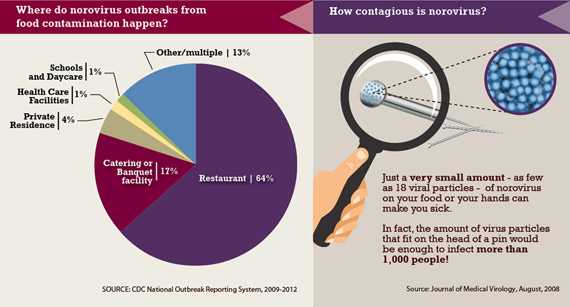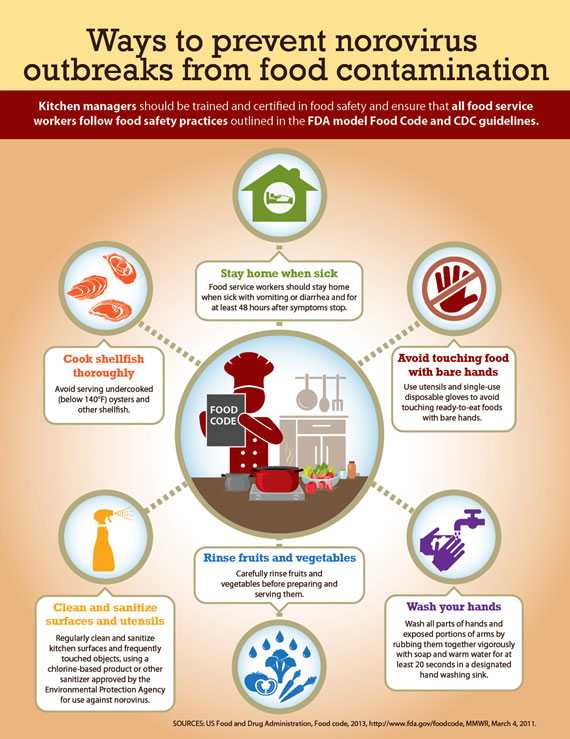Preventing Norovirus Outbreaks
Food service has a key role.
June 2014


 20M
20M
About 20 million people get sick from norovirus each year, most from close contact with infected people or by eating contaminated food.
 #1
#1
Norovirus is the leading cause of disease outbreaks from contaminated food in the US.
 70%
70%
Infected food workers cause about 70% of reported norovirus outbreaks from contaminated food.
Norovirus often gets attention for outbreaks on cruise ships, but those account for only about 1% of all reported norovirus outbreaks. Norovirus is very contagious, and outbreaks can occur anywhere people gather or food is served. People with norovirus usually vomit and have diarrhea. Some may need to be hospitalized and can even die. Infected people can spread norovirus to others through close contact or by contaminating food and surfaces. Food service workers who have norovirus can contaminate food and make many people sick. In norovirus outbreaks for which investigators reported the source of contamination, 70% are caused by infected food workers.
The food service industry can help prevent norovirus outbreaks by:
- Making sure that food service workers practice proper hand washing and avoid touching ready-to- eat foods, such as raw fruits and vegetables, with their bare hands before serving them.
- Certifying kitchen managers and training food service workers in food safety practices.
- Requiring sick food workers to stay home, and considering use of paid sick leave and on-call staffing, to support compliance.
Problem
Norovirus outbreaks from contaminated food are common in food service settings.
People infected with norovirus are very contagious.
- While sick, they shed billions of tiny viral particles in their stool and vomit. It takes a very small amount—as few as 18 viral particles—to make another person sick. People can get sick if they are exposed to a tiny amount of stool or vomit from an infected person.
- They are most contagious when sick with vomiting and diarrhea, but may also infect others before symptoms start and after they feel better.
- Because symptoms come on suddenly, an infected person who vomits in a public place may expose many people.
Food service workers often go to work when they are sick and may contaminate food.
- 1 in 5 food service workers have reported working while sick with vomiting and diarrhea. Fear of job loss and leaving coworkers short staffed were significant factors in their decision.
- Of outbreaks caused by infected food workers, 54% involve food workers touching ready-to-eat-foods with their bare hands. Ready-to-eat foods are foods that are ready to be served without additional preparation, such as washed raw fruits and vegetables for salads or sandwiches, baked goods, or items that have already been cooked.
- Observations of food service workers have shown that they practice proper hand washing only 1 of 4 times that they should.
Norovirus is hard to kill and stays on food, kitchen surfaces, and utensils. It can
- Remain infectious on foods even at freezing temperatures and until heated above 140°F.
- Stay on countertops and serving utensils for up to 2 weeks.
- Resist many common disinfectants and hand sanitizers.
Infographic
What Can Be Done
Federal government is
- Working with state and local agencies to encourage adoption and effective enforcement of all FDA model Food Code provisions, including worker health and hygiene.
- Funding state and local efforts to detect, respond, investigate, and report norovirus outbreaks more thoroughly.
- Building lab capacity for advanced molecular detection to quickly detect and track the source of norovirus outbreaks using genome sequencing and analysis.
State and local governments can
- Adopt and enforce all provisions of the FDA model Food Code to better safeguard food.
- Investigate norovirus outbreaks thoroughly to identify sources and causes and to improve control strategies.
- Participate in CDC-supported surveillance efforts to improve monitoring and evaluation of outbreaks, including the National Outbreak Reporting System, National Voluntary Environmental Assessment Information System, Norovirus Sentinel Testing and Tracking, and CaliciNet.
Food service industry can
- Adhere to food safety laws and regulations.
- Certify kitchen managers and train food service workers in food safety practices.
- Establish policies that require workers to stay home while sick with vomiting and diarrhea and for at least 48 hours after symptoms stop.
- Foster a work environment that encourages workers to stay home when sick, by considering such measures such as paid sick leave and a staffing plan that includes on-call workers.
Food service workers can
- Tell a manager when sick with vomiting and diarrhea.
- Wash hands carefully and often with soap and warm water for at least 20 seconds (time it takes to sing the "Happy Birthday" song through twice), especially after using the restroom.
- Use utensils and single-use disposable gloves to avoid touching ready-to-eat foods with bare hands.
- Regularly clean and sanitize kitchen surfaces and frequently touched objects, using a chlorinebased product or other sanitizer approved by the Environmental Protection Agency for use against norovirus.
- Immediately block off, clean, and disinfect areas where there has been a vomiting or diarrheal incident.
- Carefully wash fruits and vegetables and avoid serving undercooked (below 140°F) oysters and other shellfish.
Everyone can
- Wash hands carefully and often with soap and warm water for at least 20 seconds, and avoid preparing food for others while sick.
- Report suspected illness from food to your local health department.
- Visit www.FoodSafety.gov for the latest information.
Science Behind the Issue
Related Pages
- Vital Signs MMWR: Foodborne Norovirus Outbreaks — United States, 2009–2012
- Vital Signs – Preventing Norovirus Outbreaks [PODCAST – 1:15 minutes]
- Vital Signs – Preventing Norovirus Outbreaks [PSA – 0:60 seconds]
- CDC Digital Press Kit
- CDC: Norovirus
- CDC: Norovirus (website en Español)
- CDC Features: Prevent the Spread of Norovirus
- CDC Features: Surveillance for Norovirus Outbreaks
- Winnable Battles: Food Safety
- CDC and Food Safety
- National Outbreak Reporting System (NORS)
- CaliciNet
- Norovirus Sentinel Testing and Tracking (NoroSTAT)
- Foodborne Outbreaks
- Foodborne Outbreak Tracking and Reporting
- Foodborne Illness Surveillance Systems
- National Environmental Assessment Reporting System (NEARS)
- Environmental Health Specialists Network Food Safety Projects
- Environmental Health Specialists Network Plain Language Study Findings
- e-Learning course: Systems approach in foodborne illness outbreak environmental assessments
- FoodNet
- Facts About Noroviruses on Cruise Ships
- Frequently Asked Questions about Gastrointestinal Illness on Cruise Ships
- Tips for Healthy Cruising
- Norovirus in Healthcare Settings
On Other Web Sites
- MedlinePlus – Food Safety
- Medline Plus – Norovirus Infections
- FoodSafety.gov
- U.S. Department of Agriculture’s Food Safety and Inspection Service (USDA-FSIS)
- Food and Drug Administration (FDA)
- NoroCORE: Collaborative for Outreach, Research, and Education
- Council to Improve Foodborne Outbreak Response: Guidelines for Foodborne Outbreak and Response
- Page last reviewed: June 3, 2014
- Page last updated: June 3, 2014
- Content source:
Error processing SSI file


 ShareCompartir
ShareCompartir

